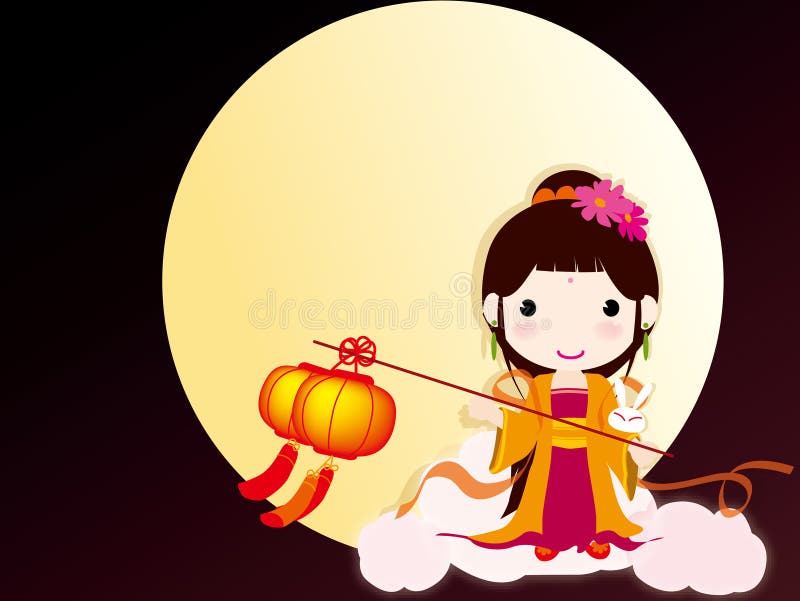

Mooncakes are offered between friends or on family gatherings while celebrating the festival. The festival is for lunar worship and moon watching mooncakes are regarded as an indispensable delicacy on this occasion. Mooncake (simplified Chinese: 月饼 traditional Chinese: 月餅 pinyin: yuè bĭng) is a Chinese bakery product traditionally eaten during the Mid-Autumn Festival / Zhongqiu Festival. Moreover, people are also fond of making interesting patterns of these tales on moon cakes.

Later, other legends about the moon, such as Wu Gang Chopping the Laurel Tree and Moon Rabbit Grinding Medicine were created, draping the moon with a mysterious veil once more. Thereby, the custom of worshiping the moon on the Mid-Autumn Festival caught on among folks. When getting to know what happened to Chang Er, common people of that time put their incense burner tables under the moon and prayed for luck and safety to the kind lady. In China, Chang Er is a synonym for the moon, and the Chinese nation has always had a special emotion towards the moon derived by the associations of fair Chang Er, which has even influenced the nation in all aspects. Many poets in ancient China cited the subject in their poems, in order to deliver Chang Er’s loneliness, chillness and solitude in the moon palace.

It is said that she regretted for what she had done soon after she flied to the moon. The moon is also called “Moon Palace” by the Chinese to describe the abode of Chang Er. Chang Er rose up to the sky immediately after that and lived on the moon ever since. The hero was rewarded with a kind of elixir for his deed, which was then eaten by his wife by stealth. Chang Er was the wife of the legendary hero Hou Yi, a great archer who accomplished great achievements by shooting down nine extra suns. The legend Chang Er Flying to the Moon is a beautiful fable of ancient China. Lobster and salmon are particular favorites along with apples, pomegranates, roasted peanuts, pomelo, chestnuts, fatt koh (sponge cakes) and moon cakes. Traditional foods for a Chinese Mid-Autumn feast are red - for good luck. In Hong Kong, Malaysia and Singapore, it’s sometimes referred to as the Lantern Festival, (not to be confused with a similar celebration during the Chinese New Year), but whatever name it goes by, the centuries-old festival remains a beloved annual ritual celebrating an abundance of food and family. The festival dates back to the Tang dynasty in 618 A.D., and as with many celebrations in China there are ancient legends closely associated with it. It is also a romantic night for lovers, who sit holding hands on hilltops, riverbanks and park benches, captivated by the brightest moon of the year! During the Mid-Autumn Festival, children are delighted to stay up past midnight, parading multi-colored lanterns into the wee hours as families take to the streets to moon-gaze. Chinese people believe that on that day, the moon is the roundest and brightest signaling a time of completeness and abundance. The Harvest Moon or Mid-Autumn Festival (Zhong Qiu Jie) is a day of family reunions much like a Western Thanksgiving. The date in the Western calendar changes annually. In China and throughout many Asian countries people celebrate the Harvest Moon on the 15th day of the eighth month of their lunar calendar. Local people like to pick fresh osmanthus flowers for delicious food preparing. In Nanjing, the festival coincides with the blooming season of sweet-scented osmanthus flowers. In addition, various parts of the country and all ethnic minorities have different Mid-Autumn Festival customs. Generally speaking, eating moon cakes, enjoying the moon and lighting up lanterns are common traditions on the festival. It dates back thousands of years and the modern-day festive customs were gradually formed over the years. The festival is also a time to celebrate a good autumn harvest. The origin of the Mid-Autumn Festival derived from the tradition of worshipping the Goddess of Moon.

Those unable to get home to join the get-together miss their family even more on the festival. As such, the Mid-Autumn Festival is a time for family reunion. The moon on the night of the 15th day of lunar August is believed to be fuller and brighter than in other months. It is the most important festival after the Chinese Lunar New Year. The 15th day of every 8th lunar month is the traditional Chinese Mid-Autumn Festival. The Legend of the Mooncake Festival: The Story of Chang-E


 0 kommentar(er)
0 kommentar(er)
